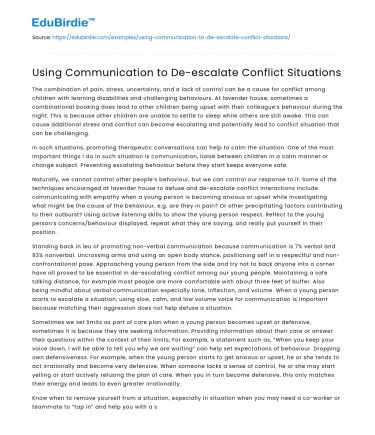The combination of pain, stress, uncertainty, and a lack of control can be a cause for conflict among children with learning disabilities and challenging behaviours. At lavender house, sometimes a combinational booking does lead to other children being upset with their colleague’s behaviour during the night. This is because other children are unable to settle to sleep while others are still awake. This can cause additional stress and conflict can become escalating and potentially lead to conflict situation that can be challenging.
In such situations, promoting therapeutic conversations can help to calm the situation. One of the most important things I do in such situation is communication, liaise between children in a calm manner or change subject. Preventing escalating behaviour before they start keeps everyone safe.
Save your time!
We can take care of your essay
- Proper editing and formatting
- Free revision, title page, and bibliography
- Flexible prices and money-back guarantee
Naturally, we cannot control other people’s behaviour, but we can control our response to it. Some of the techniques encouraged at lavender house to defuse and de-escalate conflict interactions include communicating with empathy when a young person is becoming anxious or upset while investigating what might be the cause of the behaviour, e.g. are they in pain? Or other precipitating factors contributing to their outburst? Using active listening skills to show the young person respect. Reflect to the young person’s concerns/behaviour displayed, repeat what they are saying, and really put yourself in their position.
Standing back in leu of promoting non-verbal communication because communication is 7% verbal and 93% nonverbal. Uncrossing arms and using an open body stance, positioning self in a respectful and non-confrontational pose. Approaching young person from the side and try not to back anyone into a corner have all proved to be essential in de-escalating conflict among our young people. Maintaining a safe talking distance, for example most people are more comfortable with about three feet of buffer. Also being mindful about verbal communication especially tone, inflection, and volume. When a young person starts to escalate a situation, using slow, calm, and low volume voice for communication is important because matching their aggression does not help defuse a situation.
Sometimes we set limits as part of care plan when a young person becomes upset or defensive, sometimes it is because they are seeking information. Providing information about their care or answer their questions within the context of their limits, For example, a statement such as, “When you keep your voice down, I will be able to tell you why we are waiting” can help set expectations of behaviour. Dropping own defensiveness. For example, when the young person starts to get anxious or upset, he or she tends to act irrationally and become very defensive. When someone lacks a sense of control, he or she may start yelling or start actively refusing the plan of care. When you in turn become defensive, this only matches their energy and leads to even greater irrationality.
Know when to remove yourself from a situation, especially in situation when you may need a co-worker or teammate to “tap in” and help you with a situation. The protocol says that If you are ever truly feeling threatened, to do not handle the situation alone. Keeping yourself and your colleges and other young people safe always is the main priority
De-escalating an anxious or tense situations helps prevent violence or conflict and keeps everyone—staff and young person/people safe. I always update my PRICE training skills every year. this is to keep up to date with new and existing manual handling techniques as well as up-dating the care plan and needs of our young people.






 Stuck on your essay?
Stuck on your essay?

